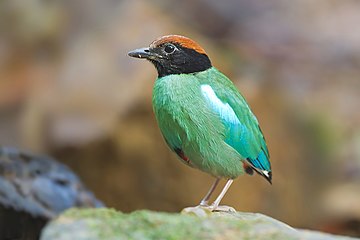Wikipedia:Picture of the day/March 2015
|
Featured picture tools: |
These featured pictures, as scheduled below, appeared as the picture of the day (POTD) on the English Wikipedia's Main Page in March 2015. Individual sections for each day on this page can be linked to with the day number as the anchor name (e.g. [[Wikipedia:Picture of the day/March 2015#1]] for March 1).
You can add an automatically updating POTD template to your user page using {{Pic of the day}} (version with blurb) or {{POTD}} (version without blurb). For instructions on how to make custom POTD layouts, see Wikipedia:Picture of the day.
March 1

|
A book used for cigarette smuggling, on display at the main customs office in Munich, Germany. This practice generally involves the illicit transportation of cigarettes or cigars from one place to another with higher taxation on sale and consumption, and is thus a form of tax evasion. Photograph: High Contrast
Recently featured: |
March 2

|
A portrait of a snow leopard (Panthera uncia) at the Rheintal Zoo in Germany. This species of big cat in the genus Panthera is native to the mountain ranges of Central and South Asia. The snow leopard's adaptations for life in a cold, mountainous environment include a stocky body, thick fur, small rounded ears to minimize heat loss, and a short muzzle with unusually large nasal cavities that help the animal breathe the cold, thin air. Photograph: Tambako The Jaguar
Recently featured: |
March 3

|
The Woman Suffrage Parade of 1913, held in Washington, D.C., was a suffragist parade organized by Alice Paul for the National American Woman Suffrage Association. On March 3, 1913, the day before President Woodrow Wilson's inauguration, thousands of suffragists marched down Pennsylvania Avenue "in a spirit of protest against the present political organization of society, from which women are excluded". The march and the attention it attracted were important in advancing women's suffrage in the United States. Illustration: Benjamin Moran Dale; restoration: Adam Cuerden
Recently featured: |
March 4

|
The hooded pitta (Pitta sordida) is a passerine bird commonly found in eastern and southeastern Asia and maritime Southeast Asia. Reaching a length of 16 to 19 centimetres (6.3 to 7.5 in), these birds feed on insects and berries. Photograph: JJ Harrison
Recently featured: |
March 5

|
The Portrait of Bindo Altoviti is an oil painting on canvas completed around 1515 by the Italian High Renaissance painter Raphael. It depicts Bindo Altoviti, a rich banker born of Florentine origin who was in his mid-twenties when he commissioned this work. The painting remained in Altoviti's family until the 1800s, and after a series of sales it was ultimately acquired by the National Gallery of Art in Washington, D.C. Painting: Raphael
Recently featured: |
March 6

|
Detail of the tiled facade on the Dome of the Rock, a shrine located on the Temple Mount in the Old City of Jerusalem. Completed in 691 CE, at the order of Umayyad Caliph Abd al-Malik, it is one of the oldest extant works of Islamic architecture. It contains the Foundation Stone, which is religiously significant for Jews, Christians and Muslims alike. The tile work on the facade of the shrine dates back to the reign of Suleiman the Magnificent (1520 to 1566) and took seven years to install. Many of the tiles were replaced during a restoration project which began in 1955, as the originals had been dislodged by rain. Photograph: Andrew Shiva
Recently featured: |
March 7

|
|
Fantasia, also known as lab el baroud ("the gunpowder play"), is a traditional exhibition of horsemanship in the Maghreb region of North Africa. A group of horse riders, all wearing traditional clothes, charge along a straight path at the same speed before firing into the sky using old muskets or muzzle-loading rifles at the end of the charge. It is considered to symbolize a strong relationship between the man and the horse. Photograph: Maxim Massalitin
Recently featured: |
March 8

|
Self-Portrait as the Allegory of Painting is an oil painting on canvas by the Italian Baroque artist Artemisia Gentileschi, probably completed between 1638 and 1639. This work is thought to depict the artist as the “Allegory of Painting”, a bold claim at a time when women were rarely given recognition for their work. Measuring 96.5 cm × 73.7 cm (38.0 in × 29.0 in), this painting is now in the British Royal Collection. Painting: Artemisia Gentileschi
Recently featured: |
March 9

|
Vipera dinniki is a species of venomous viper which can reach 48.6 cm (19.1 in) in length. First described by Alexander Nikolsky in 1913, V. dinniki is found in the highlands of Russia, Georgia, and Azerbaijan. Photograph: Benny Trapp
Recently featured: |
March 10

|
Ane Brun (b. 1976) is a Norwegian songwriter, guitarist and vocalist. She has recorded eight albums, starting in 2003 with Spending Time with Morgan. Photo: Benoît Derrier; edit: Keraunoscopia
Recently featured: |
March 11

|
The Littrow projection, created by Joseph Johann Littrow in 1838, is a conformal retroazimuthal map projection. It allows direct measurement of the azimuth from any point on the map to the center. Map: Strebe, using Geocart
Recently featured: |
March 12

|
Jaimie Alexander (b. 1984) is an American actress who made her debut in the 2006 film The Other Side. After a series of television and film roles, in 2007 she was cast as Jessi Hollander in the ABC Family series Kyle XY; she portrayed the role until the series was canceled in 2009. Two years later she took on the role of Sif in the live-action superhero film, Thor; she has reprised this role in the sequel, Thor: The Dark World (2013), and the tie-in series Agents of S.H.I.E.L.D. Photograph: Richard Goldschmidt; edit: Keraunoscopia
Recently featured: |
March 13

|
A dorsal view of a swallow-tailed gull (Creagrus furcatus) taken on Española Island, one of the Galapagos Islands where the gulls often breed. This species of nocturnal seabird spends most of its life flying and hunting for squid and small fish over the open ocean. Photograph: Benjamint444
Recently featured: |
March 14

|
Cover of the c. 1895 edition of the vocal score to The Mikado. First performed in London in 1885, The Mikado is the ninth of fourteen comic opera collaborations between the composer Arthur Sullivan and the dramatist W. S. Gilbert. Gilbert was able to satirise British politics and institutions freely by setting the opera in a fictionalised Japan. The story: After a cheap tailor is appointed Lord High Executioner of Titipu, he tries to save the town by pretending to execute the disguised son of the Mikado (the Emperor of Japan) for the capital offence of flirting; this scheme backfires. The Mikado's original run at the Savoy Theatre was 672 performances, nearly a record at the time. It remains one of the most frequently performed musical theatre pieces in history, with regular professional and amateur revivals. Illustration: Unknown; restoration: Adam Cuerden
Recently featured: |
March 15

|
|
The Palm House, built in the University of Helsinki Botanical Garden in 1889 to house tropical plants. It has since been refurbished several times, most recently between 1996 and 1998. The greenhouse is home to more than 800 different species of plants, and the garden grounds to more than 2,800 plants of different origins. Photograph: Alvesgaspar
Recently featured: |
March 16

|
A five-member team playing speedball, a variant of paintball in which teams are given an equal playing field through the use of bunkers (such as the inflatable Sup'Air seen here). Teams are placed on a small, open field, and must act cooperatively and aggressively to reach the goal. Photograph: Stefan Krause
Recently featured: |
March 17

|
A caterpillar of Lymantria dispar dispar, also known as the gypsy moth. First described by Carl Linnaeus in 1758, the gypsy moth is found throughout Eurasia, where it is considered a pest. The larvae emerge from egg masses in the spring, and then are dispersed by the wind and begin feeding on leaves. They are initially diurnal, but become nocturnal after their fourth molting. Photograph: Didier Descouens
Recently featured: |
March 18

|
The Railway is an oil painting on canvas completed by Édouard Manet in 1873. It depicts a young woman, modeled by Victorine Meurent, in front of an iron fence near the Gare Saint-Lazare in Paris. Beside this pensive woman is a young girl, standing at the fence and watching through the railings as a train – identified only by its steam – passes beneath them. The Railway was exhibited at the Paris Salon in 1874, where it was subject to ridicule, and with a "baffling subject" and "incoherent execution". The painting was first purchased by the baritone Jean-Baptiste Faure, and later by American entrepreneur Henry Osborne Havemeyer. It was donated to the National Gallery of Art in Washington, D.C. in 1956. Painting: Édouard Manet |
March 19

|
Tornado damage to a house in Oklahoma County from the Moore–Choctaw tornado, one of 91 confirmed tornadoes in the May 10–13, 2010 outbreak. The intensity of tornadoes can be measured using the Fujita, Enhanced Fujita, or TORRO scales, based on the amount of damage and estimated wind speeds. The Moore–Choctaw tornado, which killed two people, was initially rated an EF3, indicating significant damage to well-built structures. It was upgraded to an EF4 – capable of leveling even the most robustly built homes – after leveled homes were found in subdivisions that were difficult to access due to damage. Photograph: Win Henderson, FEMA
Recently featured: |
March 20

|
A 'K6' model red telephone box outside of St Paul's Cathedral in London. These kiosks for a public telephone were designed by Sir Giles Gilbert Scott and painted "currant red" for easy visibility. Although such telephone boxes ceased production when the KX series was introduced in 1985, they remain a common sight in Britain and some of its colonies, and are considered a British cultural icon. Photograph: Christoph Braun
Recently featured: |
March 21

|
A male red-capped plover (Charadrius ruficapillus) in breeding plumage, photographed at Ralph's Bay in Tasmania, Australia. These birds are seasonal breeders along the coast, but inland they will breed in response to unpredictable rains. The nests are found on the ground, in vicinity of wetlands, and may hold a clutch of two eggs. Photograph: JJ Harrison
Recently featured: |
March 22

|
The sinusoidal projection is a pseudocylindrical equal-area map projection. Used as early as the 16th century, this projection shows distances accurately along the central meridian and the equator; areas furthest from these lines are the most distorted. Map: Strebe, using Geocart
Recently featured: |
March 23

|
Silver Horn (1860–1940) was a Kiowa ledger artist and chief from Oklahoma. The son of a calendar keeper and grand-nephew of the tribe's Principal Chief Dohasan, Silver Horn was chosen to succeed his father as calendar keeper. Working with a variety of mediums and materials, he completed thousands of illustrations and other artworks depicting Kiowa culture, including dances, myths, and warfare. Painting: Elbridge Ayer Burbank
Recently featured: |
March 24

|
A British recruitment poster from the First World War, featuring imagery of Saint George and the Dragon. Britain in the First World War fielded more than five million troops. Enrollment was initially voluntary, and in 1914 and 1915 the British military released numerous recruitment posters to attract troops. As the war progressed there were fewer volunteers to fill the ranks, and in 1916 the Military Service Act, which provided for the conscription of single men aged 18–41, was introduced. By the end of the war the law's scope had been extended to include older and married men. Poster: Parliamentary Recruiting Committee; restoration: Adam Cuerden
Recently featured: |
March 25
Subpage 1

|
Side view of Papilio demoleus, a species of swallowtail butterfly commonly found on citrus species. First described by Carl Linnaeus in 1758, this highly adaptable species is found throughout the world. P. demoleus is considered a pest owing to its habit of feeding on cultivated citrus species; caterpillars can completely defoliate young citrus trees (shorter than 2 feet (60 cm)) and devastate citrus nurseries. Photograph: Jeevan Jose
Recently featured: |
Subpage 2

|
Dorsal view of Papilio demoleus, a species of swallowtail butterfly commonly found on citrus species. First described by Carl Linnaeus in 1758, this highly adaptable species is found throughout the world. P. demoleus is considered a pest owing to its habit of feeding on cultivated citrus species; caterpillars can completely defoliate young citrus trees (shorter than 2 feet (60 cm)) and devastate citrus nurseries. Photograph: Jeevan Jose
Recently featured: |
March 26

|
Neuschwanstein Castle is a Romanesque Revival palace commissioned by King Ludwig II of Bavaria in 1868. This castle on a rugged hill above the village of Hohenschwangau was intended to be Ludwig's personal retreat, though it was still under construction at the time of his death in 1886. It was soon thereafter opened to tourists, and remains a popular destination. Its architecture has inspired several further buildings, including Disneyland's Sleeping Beauty Castle. Photograph: Thomas Wolf
Recently featured:
|
March 27

|
Pelagia noctiluca is a bioluminescent species of jellyfish in the family Pelagiidae. Commonly found offshore in the warm and temperate waters of the oceans, it may occasionally be washed near the coastline. This specimen was photographed in a rockpool on the south coast of Sardinia, Italy. Photograph: Hans Hillewaert
Recently featured:
|
March 28

|
A 1901 series United States ten-dollar bill, a unit of the country's currency. On the obverse it depicts the explorers Meriwether Lewis and William Clark together with an American bison, and on the reverse is an allegorical figure of Columbia between two Roman-styled pillars. This large-size note measured approximately 7+2⁄5 × 3+1⁄8 inches (189 × 79 mm). Banknote: Bureau of Engraving and Printing (image courtesy of the National Numismatic Collection, National Museum of American History)
Recently featured:
|
March 29

|
|
Members of the Tanzanian Red Cross removing a victim of the 2013 Dar es Salaam building collapse from the rubble on 29 March. During this accident, in which a 16-storey residential tower collapsed onto a nearby mosque, more than sixty victims were caught inside the rubble; thirty-six, including five children, died. The cause of the accident was determined to be shoddy construction: poor materials were used, and the building was six stories taller than permitted. Photograph: Muhammad Mahdi Karim
Recently featured: |
March 30

|
Tule fog is a thick ground fog that settles in the San Joaquin Valley and Sacramento Valley areas of California's Great Central Valley during the state's rainy season. It forms when there is a high relative humidity (typically after a heavy rain), calm winds, and rapid cooling during the night, and is typically confined to the Great Central Valley region by the surrounding mountain ranges. Tule fog, a low cloud usually below 2,000 feet (610 m) in altitude, is highly immobile and can last for weeks if undisturbed. This fog is the leading cause of weather-related deaths in California. Photograph: Jeff Schmaltz/NASA |
March 31

|
A 1909 poster for the Indianapolis Motor Speedway, a raceway in Speedway, Indiana, which first opened on August 12 of that year. Constructed in a period of five months for $3 million, the track is relatively flat, two-and-a-half miles (four kilometers) long, and oval in shape. The speedway has changed little since it first opened, although a modern infield road course was completed in 2000. The Indianapolis Motor Speedway, which hosts such races as the Indianapolis 500 and Brickyard 400, was designated a National Historic Landmark in 1987. Poster: Otis Lithograph Co; restoration: Adam Cuerden and Chris Woodrich |
Picture of the day archives and future dates
